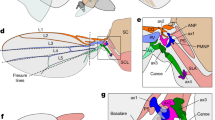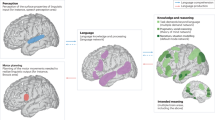Abstract
For vocal animals, recognizing species-specific vocalizations is important for survival and social interactions. In humans, a voice region has been identified that is sensitive to human voices and vocalizations. As this region also strongly responds to speech, it is unclear whether it is tightly associated with linguistic processing and is thus unique to humans. Using functional magnetic resonance imaging of macaque monkeys (Old World primates, Macaca mulatta) we discovered a high-level auditory region that prefers species-specific vocalizations over other vocalizations and sounds. This region not only showed sensitivity to the 'voice' of the species, but also to the vocal identify of conspecific individuals. The monkey voice region is located on the superior-temporal plane and belongs to an anterior auditory 'what' pathway. These results establish functional relationships with the human voice region and support the notion that, for different primate species, the anterior temporal regions of the brain are adapted for recognizing communication signals from conspecifics.
This is a preview of subscription content, access via your institution
Access options
Subscribe to this journal
Receive 12 print issues and online access
$209.00 per year
only $17.42 per issue
Buy this article
- Purchase on Springer Link
- Instant access to full article PDF
Prices may be subject to local taxes which are calculated during checkout






Similar content being viewed by others
References
Van Lancker, D.R. & Canter, G.J. Impairment of voice and face recognition in patients with hemispheric damage. Brain Cogn. 1, 185–195 (1982).
Van Lancker, D.R., Cummings, J.L., Kreiman, J. & Dobkin, B.H. Phonagnosia: a dissociation between familiar and unfamiliar voices. Cortex 24, 195–209 (1988).
Belin, P., Zatorre, R.J., Lafaille, P., Ahad, P. & Pike, B. Voice-selective areas in human auditory cortex. Nature 403, 309–312 (2000).
Belin, P., Zatorre, R.J. & Ahad, P. Human temporal-lobe response to vocal sounds. Brain Res. Cogn. Brain Res. 13, 17–26 (2002).
Fecteau, S., Armony, J.L., Joanette, Y. & Belin, P. Is voice processing species-specific in human auditory cortex? An fMRI study. Neuroimage 23, 840–848 (2004).
Altmann, C.F., Doehrmann, O. & Kaiser, J. Selectivity for animal vocalizations in the human auditory cortex. Cereb Cortex 17, 2601–2608 (2007).
Belin, P. & Zatorre, R.J. Adaptation to speaker's voice in right anterior temporal lobe. Neuroreport 14, 2105–2109 (2003).
Tanaka, K., Saito, H., Fukada, Y. & Moriya, M. Coding visual images of objects in the inferotemporal cortex of the macaque monkey. J. Neurophysiol. 66, 170–189 (1991).
Sergent, J., Ohta, S. & MacDonald, B. Functional neuroanatomy of face and object processing. A positron emission tomography study. Brain 115, 15–36 (1992).
Kanwisher, N., McDermott, J. & Chun, M.M. The fusiform face area: a module in human extrastriate cortex specialized for face perception. J. Neurosci. 17, 4302–4311 (1997).
Tsao, D.Y., Freiwald, W.A., Tootell, R.B. & Livingstone, M.S. A cortical region consisting entirely of face-selective cells. Science 311, 670–674 (2006).
Uppenkamp, S., Johnsrude, I.S., Norris, D., Marslen-Wilson, W. & Patterson, R.D. Locating the initial stages of speech-sound processing in human temporal cortex. Neuroimage 31, 1284–1296 (2006).
Obleser, J. et al. Vowel sound extraction in anterior superior temporal cortex. Hum. Brain Mapp. 27, 562–571 (2006).
Hauser, M.D., Chomsky, N. & Fitch, W.T. The faculty of language: what is it, who has it, and how did it evolve? Science 298, 1569–1579 (2002).
Masataka, N. Development of vocal recognition of mothers in infant Japanese macaques. Dev. Psychobiol. 18, 107–114 (1985).
Rendall, D., Owren, M.J. & Rodman, P.S. The role of vocal tract filtering in identity cueing in rhesus monkey (Macaca mulatta) vocalizations. J. Acoust. Soc. Am. 103, 602–614 (1998).
Ghazanfar, A.A. et al. Vocal-tract resonances as indexical cues in rhesus monkeys. Curr. Biol. 17, 425–430 (2007).
Winter, P. & Funkenstein, H.H. The effect of species-specific vocalization on the discharge of auditory cortical cells in the awake squirrel monkey. (Saimiri sciureus). Exp. Brain Res. 18, 489–504 (1973).
Suga, N., Niwa, H., Taniguchi, I. & Margoliash, D. The personalized auditory cortex of the mustached bat: adaptation for echolocation. J. Neurophysiol. 58, 643–654 (1987).
Tian, B., Reser, D., Durham, A., Kustov, A. & Rauschecker, J.P. Functional specialization in rhesus monkey auditory cortex. Science 292, 290–293 (2001).
Wang, X. & Kadia, S.C. Differential representation of species-specific primate vocalizations in the auditory cortices of marmoset and cat. J. Neurophysiol. 86, 2616–2620 (2001).
Belin, P. Voice processing in human and non-human primates. Phil. Trans. R. Soc. Lond. B 361, 2091–2107 (2006).
Poremba, A. et al. Species-specific calls evoke asymmetric activity in the monkey's temporal poles. Nature 427, 448–451 (2004).
Gil-da-Costa, R. et al. Toward an evolutionary perspective on conceptual representation: species-specific calls activate visual and affective processing systems in the macaque. Proc. Natl. Acad. Sci. USA 101, 17516–17521 (2004).
Gil-da-Costa, R. et al. Species-specific calls activate homologs of Broca's and Wernicke's areas in the macaque. Nat. Neurosci. 9, 1064–1070 (2006).
Petkov, C.I., Kayser, C., Augath, M. & Logothetis, N.K. Functional imaging reveals numerous fields in the monkey auditory cortex. PLoS Biol. 4, e215 (2006).
Kayser, C., Petkov, C.I., Augath, M. & Logothetis, N.K. Functional imaging reveals visual modulation of specific fields in auditory cortex. J. Neurosci. 27, 1824–1835 (2007).
Rauschecker, J.P. Parallel processing in the auditory cortex of primates. Audiol. Neurootol. 3, 86–103 (1998).
Romanski, L.M. et al. Dual streams of auditory afferents target multiple domains in the primate prefrontal cortex. Nat. Neurosci. 2, 1131–1136 (1999).
Kaas, J.H. & Hackett, T.A. 'What' and 'where' processing in auditory cortex. Nat. Neurosci. 2, 1045–1047 (1999).
Rauschecker, J.P. & Tian, B. Mechanisms and streams for processing of “what” and “where” in auditory cortex. Proc. Natl. Acad. Sci. USA 97, 11800–11806 (2000).
Rauschecker, J.P., Tian, B. & Hauser, M. Processing of complex sounds in the macaque nonprimary auditory cortex. Science 268, 111–114 (1995).
Wessinger, C.M. et al. Hierarchical organization of the human auditory cortex revealed by functional magnetic resonance imaging. J. Cogn. Neurosci. 13, 1–7 (2001).
Pandya, D.N. & Sanides, F. Architectonic parcellation of the temporal operculum in rhesus monkey and its projection pattern. Z. Anat. Entwicklungsgesch. 139, 127–161 (1973).
Hackett, T.A., Stepniewska, I. & Kaas, J.H. Subdivisions of auditory cortex and ipsilateral cortical connections of the parabelt auditory cortex in macaque monkeys. J. Comp. Neurol. 394, 475–495 (1998).
Kaas, J.H. & Hackett, T.A. Subdivisions of auditory cortex and processing streams in primates. Proc. Natl. Acad. Sci. USA 97, 11793–11799 (2000).
Grill-Spector, K. & Malach, R. fMR-adaptation: a tool for studying the functional properties of human cortical neurons. Acta Psychol. (Amst.) 107, 293–321 (2001).
Hauser, M.D. & Marler, P. Food-associated calls in rhesus macaques (Macaca mulatta). I. Socioecological factors. Behav. Ecol. 4, 194–205 (1993).
Formisano, E. et al. Mirror-symmetric tonotopic maps in human primary auditory cortex. Neuron 40, 859–869 (2003).
Ghazanfar, A.A. & Miller, C.T. Language evolution: loquacious monkey brains? Curr. Biol. 16, R879–R881 (2006).
Alain, C., Arnott, S.R., Hevenor, S., Graham, S. & Grady, C.L. “What” and “where” in the human auditory system. Proc. Natl. Acad. Sci. USA 98, 12301–12306 (2001).
Scott, S.K., Blank, C.C., Rosen, S. & Wise, R.J. Identification of a pathway for intelligible speech in the left temporal lobe. Brain 123, 2400–2406 (2000).
Kayser, C., Petkov, C.I., Augath, M. & Logothetis, N. Integration of touch and sound in auditory cortex. Neuron 48, 373–384 (2005).
Ghazanfar, A.A., Maier, J.X., Hoffman, K.L. & Logothetis, N.K. Multisensory integration of dynamic faces and voices in rhesus monkey auditory cortex. J. Neurosci. 25, 5004–5012 (2005).
Mullette-Gillman, O.A., Cohen, Y.E. & Groh, J.M. Eye-centered, head-centered, and complex coding of visual and auditory targets in the intraparietal sulcus. J. Neurophysiol. 94, 2331–2352 (2005).
Schroeder, C.E. & Foxe, J. Multisensory contributions to low-level, 'unisensory' processing. Curr. Opin. Neurobiol. 15, 454–458 (2005).
Hackett, T.A., Preuss, T.M. & Kaas, J.H. Architectonic identification of the core region in auditory cortex of macaques, chimpanzees and humans. J. Comp. Neurol. 441, 197–222 (2001).
Fullerton, B.C. & Pandya, D.N. Architectonic analysis of the auditory-related areas of the superior temporal region in human brain. J. Comp. Neurol. 504, 470–498 (2007).
Leopold, D.A., Bondar, I.V. & Giese, M.A. Norm-based face encoding by single neurons in the monkey inferotemporal cortex. Nature 442, 572–575 (2006).
Sereno, M.I. & Tootell, R.B. From monkeys to humans: what do we now know about brain homologies? Curr. Opin. Neurobiol. 15, 135–144 (2005).
Acknowledgements
We are grateful to P. Belin, T. Hackett, D. Leopold, M. Mishkin and K. Tanji for useful discussions and suggestions throughout the study. We recognize the contribution of the nonhuman primates. This work was supported by the Max-Planck Society, the Deutsche Forschungsgemeinschaft and the Alexander von Humboldt Foundation.
Author information
Authors and Affiliations
Contributions
C.I.P. conceived and designed the experiments. C.I.P., C.K., T.S. and M.A. carried out the experiments. C.I.P. analyzed the data and wrote the paper. C.K. and N.K.L. contributed conceptually and with data analysis. C.I.P., C.K., T.S., K.W., M.A. and N.K.L. provided materials and analysis tools.
Corresponding author
Supplementary information
Supplementary Text and Figures
Supplementary Figures 1–4 and Methods (PDF 214 kb)
Rights and permissions
About this article
Cite this article
Petkov, C., Kayser, C., Steudel, T. et al. A voice region in the monkey brain. Nat Neurosci 11, 367–374 (2008). https://doi.org/10.1038/nn2043
Received:
Accepted:
Published:
Issue Date:
DOI: https://doi.org/10.1038/nn2043
This article is cited by
-
Is song processing distinct and special in the auditory cortex?
Nature Reviews Neuroscience (2023)
-
Socially meaningful visual context either enhances or inhibits vocalisation processing in the macaque brain
Nature Communications (2022)
-
Cerebral Activity in Female Baboons (Papio anubis) During the Perception of Conspecific and Heterospecific Agonistic Vocalizations: a Functional Near Infrared Spectroscopy Study
Affective Science (2022)
-
Auditory cortical micro-networks show differential connectivity during voice and speech processing in humans
Communications Biology (2021)
-
Repetition enhancement to voice identities in the dog brain
Scientific Reports (2020)



